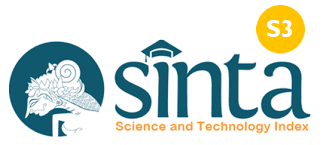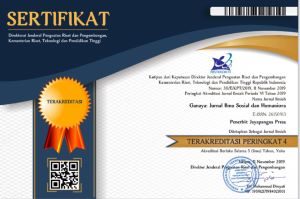Tingkat Literasi Digital dan Pengaruhnya terhadap Keterampilan Abad-21 Mahasiswa ditinjau dari Perspektif Gender
DOI:
https://doi.org/10.37329/cetta.v6i4.2760Keywords:
Digital Literacy, Gender, 21st Century SkillsAbstract
The 21st century is known for its rapid technological developments, one of which is the development of digital technology. This digital technology has penetrated various fields, including education. This research aims examine the level of digital literacy and its influence on students' 21st century skills from a gender perspective. This research method is a quantitative method. The research population is active students of the Tadris Physics study program who are currently attending lectures in the first to fourth years. The research sample consisted of 38 students (19 male students and 19 female students), selected using the quota sampling technique. Data collection in this research was carried out using questionnaires and interviews. The research instruments are 2 main questionnaires that can gather information about students' digital literacy levels and students' achievement of 21st century skills. Data analysis was conducted by calculating the average score for students' digital literacy and 21st century skills based on gender. Furthermore, an analysis of the relationship between digital literacy and students' 21st century skills will also be carried out. The relationship between the two variables was analyzed using a simple regression test. The results of data analysis show that the level of digital literacy and 21st century abilities of students is in the “good” category. However, for both variables there are no significant differences between male and female students with the significance values of the difference test results for digital literacy and 21st century skills being 0.125 and 0.747 respectively (both greater than 0.05). Furthermore, the results of the regression analysis revealed a statiscally significant positive influence of digital literacy on students' 21st century skills, with an F-value of 20.145 and a significance level of 0.000 < 0.05.
References
Alismail, H. A., & McGuire, P. (2015). 21st century standards and curriculum: Current research and practice. Journal of Education and Practice, 6(6), 150–154.
Asari, A., Kurniawan, T., Ansor, S., & Putra, A. B. N. R. (2019). Kompetensi literasi digital bagi guru dan pelajar di lingkungan sekolah kabupaten Malang. BIBLIOTIKA: Jurnal Kajian Perpustakaan Dan Informasi, 3(2), 98–104.
Blum, L., Frieze, C., Hazzan, O., & Dias, M. B. (2007). A cultural perspective on gender diversity in computing. Wellesley, Massachusetts: CRC Press.
Cahyono, B. (2017). Analisis ketrampilan berfikir kritis dalam memecahkan masalah ditinjau perbedaan gender. AKSIOMA: Jurnal Matematika Dan Pendidikan Matematika, 8(1), 50–64.
Cronin, C., & Roger, A. (1999). Theorizing progress: Women in science, engineering, and technology in higher education. Journal of Research in Science Teaching, 36(6), 637–661.
Hermawati, W. (2018). Gender dalam ilmu pengetahuan dan teknologi: Perkembangan, kebijakan & tantangannya di Indonesia. LIPI Press.
Hobbs, R. (2017). Create to learn: Introduction to digital literacy. John Wiley & Sons.
Huda, H. D., & Dodi, L. (2020). Rethinking Peran Perempuan dan Keadilan Gender: Sebuah Konstruksi Metodologis Berbasis Sejarah dan Perkembangan Sosial Budaya. CV Cendekia Press.
Kajin, S. (2018). Pengaruh pembelajaran berbasis literasi digital terhadap motivasi dan hasil belajar kognitif di MTs N Mojosari dan MTs N Sooko Mojokerto. PROGRESSA Journal of Islamic Religious Instruction, 2(1), 133–142.
Kennedy, T. J., & Sundberg, C. W. (2020). 21st Century Skills. In B. Akpan & T. J. Kennedy (Eds.), Science Education in Theory and Practice (pp. 479–496). Cham: Springer International Publishing. doi: 10.1007/978-3-030-43620-9_32
Kurnia, N., & Astuti, S. I. (2017). Peta Gerakan Literasi Digital di Indonesia: Studi Tentang Pelaku, Ragam Kegiatan, Kelompok Sasaran dan Mitra. Informasi, 47(2), 149–166.
Mahanal, S., & Zubaidah, S. (2017). Model pembelajaran Ricosre yang berpotensi memberdayakan keterampilan berpikir kreatif. Jurnal Pendidikan: Teori, Penelitian, Dan Pengembangan, 2(5), 676–685.
McDougall, J., Readman, M., & Wilkinson, P. (2018). The uses of (digital) literacy. Learning, Media and Technology, 43(3), 263–279.
Najih, M. A. (2017). Gender Dan Kemajuan Teknologi: Pemberdayaan Perempuan Pendidikan Dan Keluarga. Jurnal Harkat: Media Komunikasi Gender, 13(1), 18–26.
Pratolo, B. W., & Solikhati, H. A. (2020). The implementation of digital literacy in indonesian suburban EFL classes. International Journal of Scientific and Technology Research, 9(1), 1508–1512.
Romadona, M. R., Setiawan, S., Manalu, R., Fizzanty, T., & Yuliar, S. (2016). Budaya iptek di lembaga litbang. Jakarta: PAPPIPTEK-LIPI.
Ruenphongphun, P., Sukkamart, A., & Pimdee, P. (2021). Thai Undergraduate Digital Citizenship Skills Education: A Second-Order Confirmatory Factor Analysis. World Journal on Educational Technology: Current Issues, 13(3), 370–385.
Sholihah, M. (2022). Profil Literasi Digital Mahasiswa Calon Guru di Universitas Islam Balitar. Konstruktivisme: Jurnal Pendidikan Dan Pembelajaran, 14(2), 180–186.
Siddiq, F., & Scherer, R. (2019). Is there a gender gap? A meta-analysis of the gender differences in students’ ICT literacy. Educational Research Review, 27, 205–217.
Sinclair, B. (2017). IoT Inc: How your company can use the internet of things to win in the outcome economy. New York : McGraw-Hill Education.
Spires, H. A., Paul, C. M., & Kerkhoff, S. N. (2019). Digital literacy for the 21st century. In Advanced methodologies and technologies in library science, information management, and scholarly inquiry (pp. 12–21). IGI Global.
Sujana, A., & Rachmatin, D. (2019). Literasi digital abad 21 bagi mahasiswa PGSD: Apa, mengapa, dan bagaimana. Current Research in Education: Conference Series Journal, 1(1), 003–013.
Tang, C. M., & Chaw, L. Y. (2016). Digital Literacy: A Prerequisite for Effective Learning in a Blended Learning Environment?. Electronic Journal of E-Learning, 14(1), 54–65.
Trilling, B., & Fadel, C. (2009). 21st century skills: Learning for life in our times. John Wiley & Sons.
Yanti, E. D., Wigati, I., & Habisukan, U. H. (2019). Perbedaan Kemampuan Berpikir Kritis Laki-Laki dan Perempuan pada Materi Sistem Peredaran Darah Mata Pelajaran Biologi Kelas XI MIPA MAN I Banyuasin III. Bioilmi: Jurnal Pendidikan, 5(1), 66–71.
Yanti, N., Mulyati, Y., Sunendar, D., & Damaianti, V. (2021). Tingkat Literasi Digital Mahasiswa Indonesia. Diksa: Pendidikan Bahasa Dan Sastra Indonesia, 7(1), 59–71.
Zamista, A. A., & Azmi, K. (2023). Digital Learning: How the Process Enhances Students’ Digital Literacy. Jurnal Penelitian Pendidikan IPA, 9(9), 7189–7195.
Downloads
Published
How to Cite
Issue
Section
License
Copyright (c) 2023 Adelia Alfama Zamista, May Shanda Charona

This work is licensed under a Creative Commons Attribution-ShareAlike 4.0 International License.
An author who publishes in the Cetta : Jurnal Ilmu Pendidikan agrees to the following terms:
- Author retains the copyright and grants the journal the right of first publication of the work simultaneously licensed under the Creative Commons Attribution-ShareAlike 4.0 License that allows others to share the work with an acknowledgement of the work's authorship and initial publication in this journal
- Author is able to enter into separate, additional contractual arrangements for the non-exclusive distribution of the journal's published version of the work (e.g., post it to an institutional repository or publish it in a book) with the acknowledgement of its initial publication in this journal.
- Author is permitted and encouraged to post his/her work online (e.g., in institutional repositories or on their website) prior to and during the submission process, as it can lead to productive exchanges, as well as earlier and greater citation of the published work (See The Effect of Open Access).
Read more about the Creative Commons Attribution-ShareAlike 4.0 Licence here: https://creativecommons.org/licenses/by-sa/4.0/.





